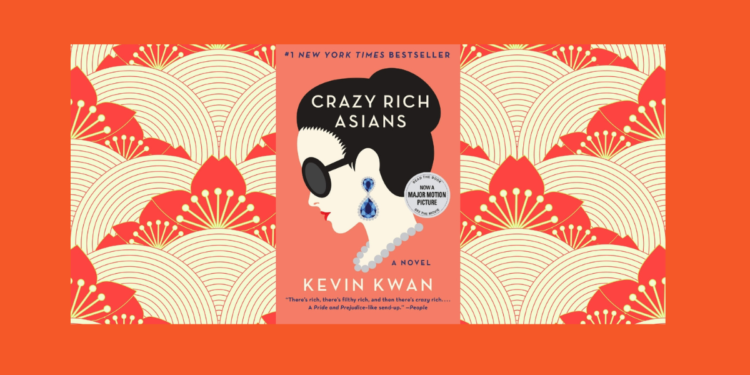“Crazy Rich Asians” is a romantic comedy novel by Kevin Kwan, first published in 2013. It is also the first book in a trilogy, followed by “China Rich Girlfriend” and “Rich People Problems.” This review will explore the novel’s characters, plot, themes, and its significance in contemporary literature and culture.
Characters:
The novel boasts a colorful and diverse cast of characters, each contributing to the intricate tapestry of the story.
- Rachel Chu: The protagonist of the story, Rachel is a down-to-earth, intelligent, and strong-willed economics professor at NYU. Her character is relatable and provides readers with an outsider’s perspective as she navigates the extravagant world of the ultra-rich in Singapore.
- Nick Young: Nick is Rachel’s boyfriend and the heir to one of the wealthiest families in Singapore. He is charming, humble, and genuinely in love with Rachel. Nick’s internal struggle between his loyalty to his family and his love for Rachel is a central conflict in the story.
- Eleanor Young: Nick’s mother, Eleanor, is a formidable character who values tradition, family, and reputation above all else. She is a complex figure who initially opposes Nick and Rachel’s relationship.
- Astrid Leong-Teo: Astrid is Nick’s cousin, and her character adds depth to the novel’s exploration of wealth and privilege. She is a fashion icon who secretly grapples with the problems that come with her status and wealth.
- Peik Lin Goh: Rachel’s best friend in Singapore, Peik Lin provides comic relief with her outrageous fashion sense and eccentric family. She helps Rachel navigate the intricate social landscape of Singapore’s elite.
- Oliver T’sien: Nick’s childhood friend and a recurring character in the story, Oliver is portrayed as the quintessential playboy with a heart of gold. His character provides both humor and insight into the world of the rich and famous.
Plot:
“Crazy Rich Asians” follows the story of Rachel and Nick as they travel to Singapore for the wedding of Nick’s best friend, Colin. The novel opens with Rachel and Nick, a seemingly ordinary couple living in New York, enjoying their quiet and comfortable life together. However, everything changes when Nick invites Rachel to spend the summer in Singapore for the wedding. Unbeknownst to Rachel, Nick’s family is one of the wealthiest and most influential in the country.
Upon their arrival in Singapore, Rachel is thrust into a world of opulence, extravagance, and family intrigue. She must navigate the complex web of social expectations, traditions, and the overbearing scrutiny of Nick’s family, particularly his disapproving mother, Eleanor. As Rachel attempts to fit in, she faces challenges and judgment from various quarters of Singaporean society, particularly from those who view her as an outsider.
The novel intertwines multiple subplots, showcasing the lives and tribulations of Nick’s extended family and friends. These subplots give readers a glimpse into the lives of Singapore’s elite and their quirky, often absurd, personalities.
The central tension in the story revolves around Rachel’s desire to earn the approval and acceptance of Nick’s family, primarily Eleanor. She faces a series of tests and obstacles, each designed to determine her worthiness to be a part of the Young family. The conflict between Rachel’s modest background and the ostentatious world of Singapore’s elite creates a compelling and relatable narrative.
Throughout the novel, Kevin Kwan skillfully weaves together elements of comedy, drama, and romance. Readers are treated to a visual feast of lavish parties, high-end fashion, and luxurious settings. The humor in the story arises from the absurdity and excess of the characters’ lifestyles, as well as the witty and often sarcastic dialogue.
The climax of the novel occurs at the extravagant wedding of Colin and Araminta, where the culmination of Rachel’s trials and tribulations takes place. The resolution provides a satisfying conclusion to the central conflict, offering a mix of poignant moments and feel-good romance.
Themes:
“Crazy Rich Asians” touches upon several prominent themes that are relevant to both the story and contemporary society:
- Love and Class: The novel explores the age-old theme of love transcending class boundaries. Rachel and Nick’s love is put to the test as they navigate the enormous gulf between their modest, middle-class backgrounds and Nick’s ultra-wealthy family. The story underscores the idea that genuine love can overcome even the most daunting social and economic differences.
- Family and Tradition: A significant theme in the novel is the importance of family and tradition, particularly within Asian societies. Nick’s loyalty to his family, his sense of duty, and his mother’s adherence to tradition create a complex web of familial relationships and expectations.
- Identity and Belonging: Rachel’s struggle to find her place in the elite social circles of Singapore raises questions about identity and belonging. Her experiences as an outsider make readers reflect on issues of identity, culture, and societal acceptance.
- Wealth and Excess: The novel portrays the extravagant lifestyles of the ultra-rich in Singapore. It critiques the excesses and opulence that can accompany immense wealth, highlighting the stark contrast between the haves and the have-nots.
- Humor and Satire: Kevin Kwan employs humor and satire to lampoon the extravagance and eccentricities of the wealthy. The novel humorously exposes the absurdity of the characters’ lives, fashion, and social customs.
Significance in Contemporary Culture:
“Crazy Rich Asians” holds a special place in contemporary literature and popular culture. Here are some reasons for its significance:
- Representation: The novel offers much-needed representation of Asian characters and culture in Western literature. It addresses the lack of diversity in mainstream literature and challenges stereotypes about Asian identity.
- Cultural Insight: The novel provides readers with a window into the lives of the super-rich in Singapore and offers cultural insights into the complexities of Asian societies, especially the pressure of societal expectations and traditions.
- Empowerment of Women: Rachel’s character serves as a strong, independent female protagonist. Her journey from being an outsider to standing up for herself and her love is empowering and resonates with readers.
- Humor and Entertainment: “Crazy Rich Asians” is a fun, entertaining read that combines humor, romance, and social commentary. Its success has prompted discussions on the importance of lighthearted literature in contemporary culture.
- Adaptation to Film: The novel’s film adaptation, released in 2018, achieved widespread acclaim for its contribution to the representation of Asian characters in Hollywood. The film brought the story to a broader audience and further solidified its cultural significance.
In conclusion, “Crazy Rich Asians” by Kevin Kwan is a delightful and entertaining novel that has left a lasting impact on contemporary literature and culture. It successfully blends themes of love, class, and identity with humor and satire. The book’s significance lies in its representation of Asian culture, the empowerment of its female protagonist, and its contribution to discussions about diversity and the power of literature to bridge cultural gaps. It remains a significant work in the realm of modern literature and continues to resonate with readers of all backgrounds.









